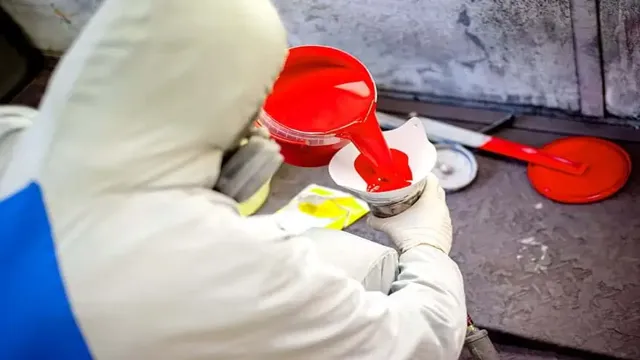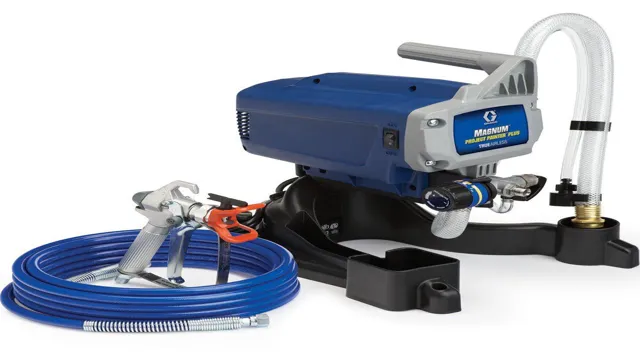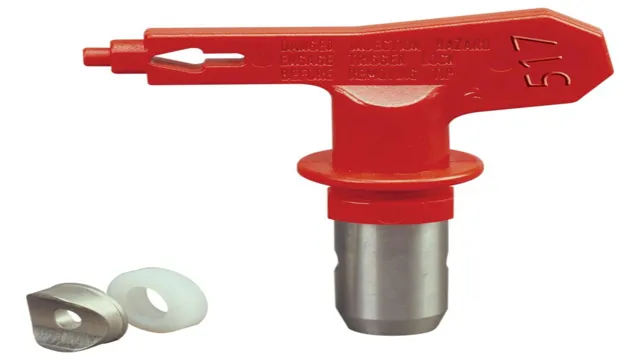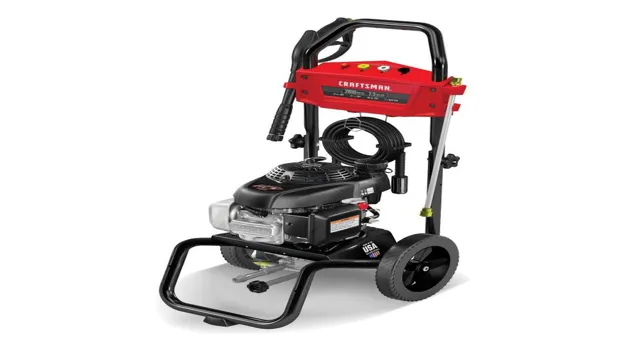
If you’re looking for a flawless finish on your painted projects, then you can’t go wrong with using a spray gun. But, did you know that the secret to getting that perfect spray is to thin your paint? That’s right! Thin paint is the key to achieving smooth and even coverage, free of drips and clogs. In this blog, we’ll be discussing the benefits of thinning paint for a spray gun, the different methods to thin your paint, and how to determine the perfect consistency for your project.
We’ll also be sharing some tips and tricks to ensure that your paint is ready to go and how to avoid common mistakes when thinning your paint. By the time you finish reading our blog, you’ll be confident in your ability to thin your paint like a pro, and achieve that picture-perfect spray finish you’ve always wanted. So, let’s delve in and learn about the art of thinning paint for a perfect spray!
The Importance of Thinning Paint for a Paint Sprayer
Have you ever encountered a problem with your paint sprayer? Perhaps the paint was too thick and didn’t spray evenly, or worse, it caused your sprayer to clog? Have no fear, because the solution to these common paint sprayer woes is simply to thin your paint. But how do you thin paint for a paint sprayer? Well, it’s actually quite simple. All you need to do is add a little bit of water or paint thinner to your paint, depending on the type of paint you’re using.
The ratio of paint to thinner will differ depending on your paint and the sprayer you’re using, so it’s important to check the manufacturer’s instructions before starting. Thinning your paint will make it easier to spray, and will help prevent clogging, resulting in a smoother and more even finish. So the next time you’re about to use your paint sprayer, don’t forget to thin your paint, and enjoy a hassle-free painting experience!
Why You Need to Thin Paint for a Paint Sprayer
Thinning paint for a paint sprayer is an essential part of the painting process that many people overlook. The importance of thinning the paint cannot be overstated as it helps to ensure that the paint is dispersed evenly onto the surface being painted. When the paint is too thick, it can clog the paint sprayer nozzle and cause an uneven application of the paint.
To achieve the desired viscosity, it is crucial to thin the paint using the manufacturer’s recommended solvent or water to dilute the paint to the proper consistency. By doing so, you also reduce the amount of overspray and paint wastage, saving you time and money. Thinning the paint also improves the finish of the paint job by preventing drips, runs, and clumps.
Remember that a well-thinned paint will create a smooth, consistent coverage with a lasting finish.

Benefits of Thinning Paint for a Paint Sprayer
Thinning paint before using it with a paint sprayer is essential. It has many benefits that will make your painting project a success. The importance of thinning paint is to ensure that it flows through the sprayer’s nozzle smoothly and that it atomizes well.
When paint is too thick, it clogs the nozzle and leads to an uneven and blotchy finish. Thinned paint also dries faster, which means that you can apply multiple coats in a shorter time frame. This gives you a smoother and consistent finish.
Another benefit of thinning paint is that it saves you money. You use less paint and can cover more surfaces with a thin layer. Overall, thinning paint is a crucial step in ensuring that your paint sprayer works well and that you get the best results from your painting project.
How to Thin Paint for a Paint Sprayer
If you are planning to use a paint sprayer for your next DIY project, it is essential to learn how to thin paint for the best results. Thinning the paint before spraying enables the paint to flow through the nozzle smoothly, resulting in a consistent and even coat. The process of thinning paint involves adding a specific amount of water or paint thinner to the paint.
The ideal ratio of paint to thinning agent varies depending on the paint manufacturer’s instructions and the type of sprayer you are using. Typically, the ratio ranges from 1:1 to 1: It is crucial to measure and mix the paint and the thinning agent thoroughly to achieve the right consistency.
If the paint is over-thinned, it may become too watery and will not provide adequate coverage. On the other hand, if it is under-thinned, it may not atomize correctly, resulting in a rough and uneven finish. In conclusion, being mindful of the manufacturer’s instructions on the amount of thinning agent to use and thoroughly mixing the paint and the agent together is key in achieving an even and smooth finish for your paint sprayer project.
Materials You’ll Need to Thin Paint
If you want to use a paint sprayer for your next painting project, then you need to know how to thin the paint properly. Thinning the paint helps the sprayer spray it evenly and smoothly onto your surface. You’ll need a few materials to thin your paint, such as a measuring cup, a stir stick, and paint thinner.
The paint thinner you choose will depend on the type of paint you’re using. For example, if you’re using oil-based paint, you’ll need to use mineral spirits, while water-based paint requires water as a thinner. When it comes to thinning your paint, you’ll want to add the thinner slowly and stir the paint thoroughly until it reaches the desired consistency.
Remember to test your paint before applying it to your surface to ensure that it’s the right thickness for your sprayer. By taking the time to thin your paint correctly, you’ll be able to achieve a professional-looking finish on your painting project. So, don’t be afraid to experiment with different thinners until you find the one that works best with your paint and sprayer.
Step-by-step Guide on How to Thin Paint for a Paint Sprayer
Thinning paint is an important step when using a paint sprayer. It allows the paint to flow smoothly through the nozzle of the sprayer without clogging, resulting in an even coat and a professional finish. The process of thinning paint involves adding a specific amount of water or solvent to the paint, depending on the type of paint being used.
The key is to follow the manufacturer’s instructions on how much paint to thin and what type of solvent to use. It’s important to never overthin the paint, as this can cause it to lose its pigment and result in a translucent finish. With a little patience and attention to detail, thinning paint for a paint sprayer can be an easy and successful process.
Tips for Thinning Paint for a Paint Sprayer
Thinning your paint when using a paint sprayer is essential to get the best results. You don’t want to end up with a thick, globby mess that won’t stick or a thin paint that won’t cover the surface. The key is to find the perfect consistency.
When choosing the right paint thinner, keep in mind that different types of paint require different thinning agents. For example, oil-based paints need mineral spirits, while water-based paints will need water or acrylic modifiers. Generally, a good rule of thumb is to use no more than 10% thinner for every gallon of paint.
It is always better to gradually add thinner to your paint, while stirring it continuously until you reach the desired consistency. One way to test this is to dip your paint sprayer and check the thickness of the paint on the surface. If the paint looks too thick, add more thinning agent and keep testing until it’s right.
With a little bit of patience and practice, you will know exactly how to thin your paint and achieve the perfect finish.
Testing the Thickness of Your Paint
When preparing to use a paint sprayer, it’s important to make sure your paint is the right thickness. So how do you thin paint for a paint sprayer? First, consult the manufacturer’s instructions for your particular sprayer. They may have specific guidelines for the consistency of the paint.
If not, a good rule of thumb is to aim for a viscosity similar to that of whole milk. You can achieve this by gradually adding small amounts of water or thinner to your paint until it reaches the desired consistency. Before you begin, it’s crucial to test the thickness of your paint by using a viscosity cup or simply spraying a small amount onto a test surface.
With the right consistency, your paint will evenly coat your surface and ensure a smooth finish.
How to Test the Thickness of Your Paint
When it comes to painting your walls, it’s important to make sure the thickness of the paint is consistent throughout. One way to do this is by testing the thickness using a paint thickness gauge. This tool measures the amount of paint on the surface and can help prevent over-applying or under-applying paint, which can lead to issues down the line.
To use the gauge, simply place it on the painted surface and press down until it clicks. The gauge will display the thickness in either mils or microns. It’s important to note that different types of paint will have different ideal thicknesses, so it’s important to consult product information or a professional for guidance.
By testing the thickness of your paint, you can ensure a smooth and long-lasting finish on your walls.
When to Stop Thinning Your Paint
As a beginner artist, it can be challenging to determine when to stop thinning your paint. One easy way to test the thickness of your paint is to use the “string test.” Dip the end of your paintbrush into the paint and hold it up in the air for a few seconds.
If the paint easily drips off the brush or forms a thick droplet, then it’s likely too thin. Keep adding small amounts of paint until the string test shows the paint sticking to the brush and forming a thin string-like trail. Another way to test the paint thickness is to use a palette knife to spread a small amount of paint on a surface.
If the paint easily spreads and forms uneven edges, then it’s too thin. If the edges are smooth and the paint stays in place, then it’s at the right thickness. Remember, it’s better to slightly under-thin your paint and slowly add more than to over-thin it and have to start over.
Wrapping Up Your Paint Thinning Process
When it comes to using a paint sprayer, thinning your paint is crucial for a good finish. So, how do you thin paint for a paint sprayer? First, start by checking the paint can label or manufacturer’s instructions to determine what type of thinner is recommended for your specific paint. Next, add small amounts of thinner to the paint while stirring constantly until it reaches the desired consistency.
Be careful not to over-thin the paint, as this can cause it to run or splatter. It’s also important to strain the paint through a fine-mesh filter to remove any lumps or debris before pouring it into the sprayer. Remember to always wear appropriate protective gear, such as gloves and a face mask, as paint thinners can be harmful to your health if not used properly.
With these simple steps, you’ll be able to achieve a perfect, even coat every time.
Conclusion
In conclusion, thinning paint for a paint sprayer is like making a fine cocktail – just like a mixologist adds the perfect amount of ingredients to achieve a smooth and balanced drink, carefully thinning your paint mixture to the optimal consistency will result in a flawless and easy application on your project. So grab your paint, stir in that thinner, and get ready to make some painting magic!”
FAQs
What type of paint is best for a paint sprayer?
Latex or acrylic-based paint is best suited for a paint sprayer.
How much thinner should you use when thinning paint for a paint sprayer?
The amount of thinner required generally varies from manufacturer to manufacturer, but a good starting point is to use a 10:1 ratio of paint to thinner.
What is the best consistency of paint for a paint sprayer?
The ideal consistency of paint for a paint sprayer is similar to that of skim milk – thin enough to flow easily through the nozzle, but not too thin that it runs or drips.
Can you use water instead of thinner to thin paint for a paint sprayer?
While water may be used to thin some types of paint, this can be problematic as it can lead to poor adhesion and durability of the finish. It is generally recommended to follow the manufacturer’s recommendations and use the appropriate thinner.
What type of thinner should be used for oil-based paint in a paint sprayer?
Mineral spirits are typically used as a thinner for oil-based paint in a paint sprayer.
How do you know if the paint in a paint sprayer is too thin?
If the paint in a paint sprayer is too thin, it may result in a drippy finish or poor coverage, and may also clog the nozzle. To avoid this, perform a test spray and adjust the consistency as required.
Can you reuse paint that has been thinned for use in a paint sprayer?
Thinned paint should not be stored for prolonged periods as it can lead to spoilage and the breakdown of the paint. It is generally recommended to only mix what is required for the job at hand.






